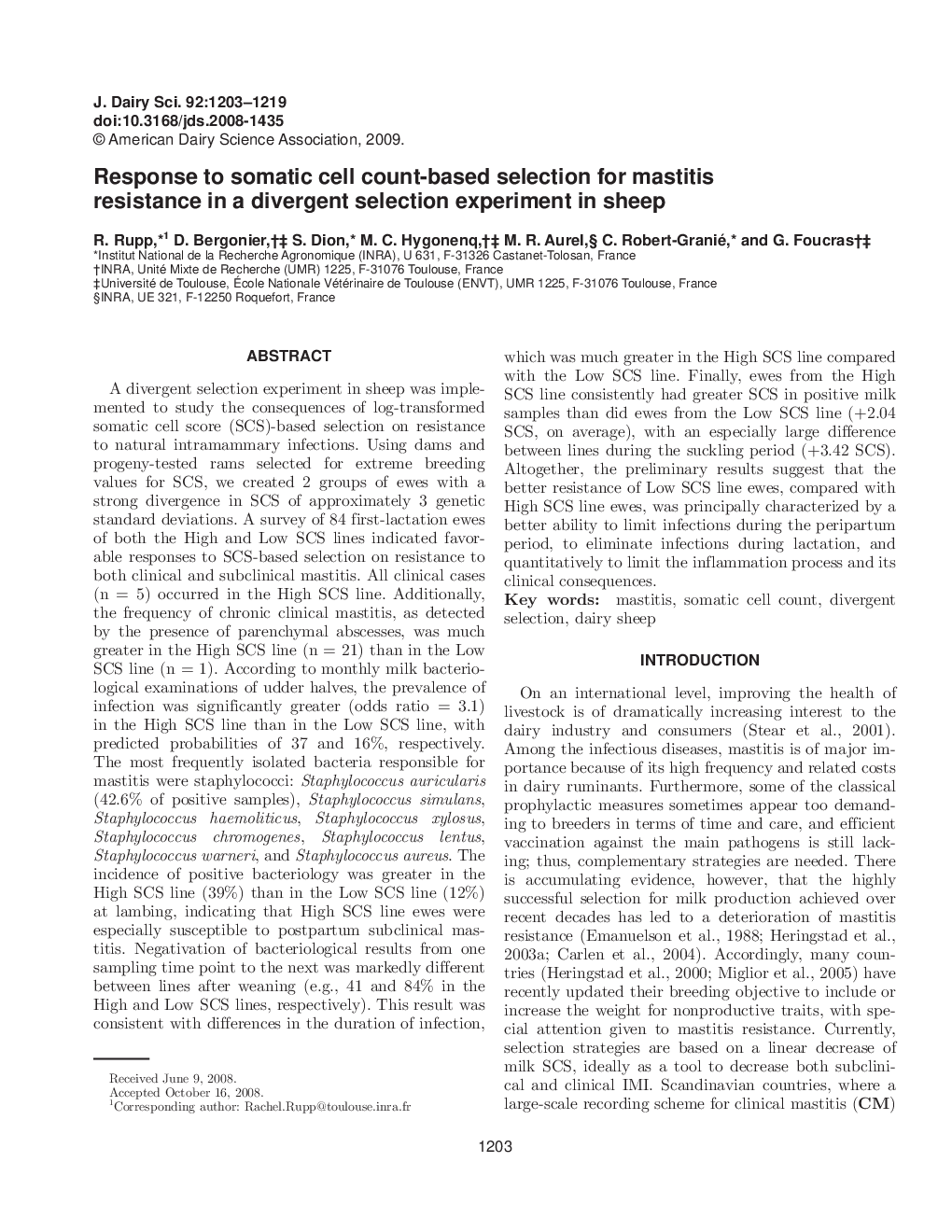| کد مقاله | کد نشریه | سال انتشار | مقاله انگلیسی | نسخه تمام متن |
|---|---|---|---|---|
| 2439876 | 1108106 | 2009 | 17 صفحه PDF | دانلود رایگان |
عنوان انگلیسی مقاله ISI
Response to somatic cell count-based selection for mastitis resistance in a divergent selection experiment in sheep
دانلود مقاله + سفارش ترجمه
دانلود مقاله ISI انگلیسی
رایگان برای ایرانیان
کلمات کلیدی
موضوعات مرتبط
علوم زیستی و بیوفناوری
علوم کشاورزی و بیولوژیک
علوم دامی و جانورشناسی
پیش نمایش صفحه اول مقاله

چکیده انگلیسی
A divergent selection experiment in sheep was implemented to study the consequences of log-transformed somatic cell score (SCS)-based selection on resistance to natural intramammary infections. Using dams and progeny-tested rams selected for extreme breeding values for SCS, we created 2 groups of ewes with a strong divergence in SCS of approximately 3 genetic standard deviations. A survey of 84 first-lactation ewes of both the High and Low SCS lines indicated favorable responses to SCS-based selection on resistance to both clinical and subclinical mastitis. All clinical cases (n = 5) occurred in the High SCS line. Additionally, the frequency of chronic clinical mastitis, as detected by the presence of parenchymal abscesses, was much greater in the High SCS line (n = 21) than in the Low SCS line (n = 1). According to monthly milk bacteriological examinations of udder halves, the prevalence of infection was significantly greater (odds ratio = 3.1) in the High SCS line than in the Low SCS line, with predicted probabilities of 37 and 16%, respectively. The most frequently isolated bacteria responsible for mastitis were staphylococci: Staphylococcus auricularis (42.6% of positive samples), Staphylococcus simulans, Staphylococcus haemoliticus, Staphylococcus xylosus, Staphylococcus chromogenes, Staphylococcus lentus, Staphylococcus warneri, and Staphylococcus aureus. The incidence of positive bacteriology was greater in the High SCS line (39%) than in the Low SCS line (12%) at lambing, indicating that High SCS line ewes were especially susceptible to postpartum subclinical mastitis. Negativation of bacteriological results from one sampling time point to the next was markedly different between lines after weaning (e.g., 41 and 84% in the High and Low SCS lines, respectively). This result was consistent with differences in the duration of infection, which was much greater in the High SCS line compared with the Low SCS line. Finally, ewes from the High SCS line consistently had greater SCS in positive milk samples than did ewes from the Low SCS line (+2.04 SCS, on average), with an especially large difference between lines during the suckling period (+3.42 SCS). Altogether, the preliminary results suggest that the better resistance of Low SCS line ewes, compared with High SCS line ewes, was principally characterized by a better ability to limit infections during the peripartum period, to eliminate infections during lactation, and quantitatively to limit the inflammation process and its clinical consequences.
ناشر
Database: Elsevier - ScienceDirect (ساینس دایرکت)
Journal: Journal of Dairy Science - Volume 92, Issue 3, March 2009, Pages 1203-1219
Journal: Journal of Dairy Science - Volume 92, Issue 3, March 2009, Pages 1203-1219
نویسندگان
R. Rupp, D. Bergonier, S. Dion, M.C. Hygonenq, M.R. Aurel, C. Robert-Granié, G. Foucras,